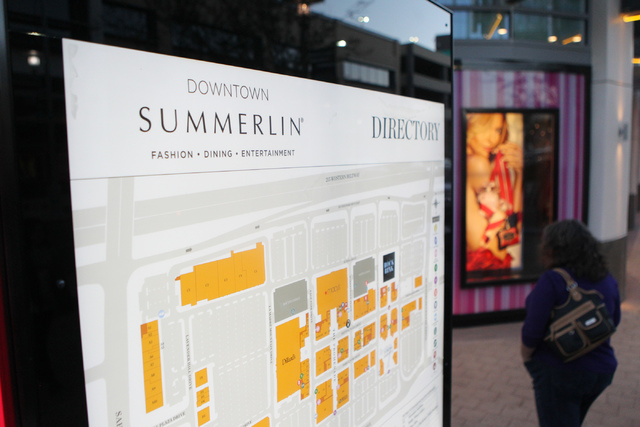2015 seen as year for commercial real estate to accelerate
The local commercial real estate market woke up in 2014.
In 2015, the market will drink its coffee and find some pep.
That’s the word from experts in the Las Vegas office of commercial brokerage CBRE, which held a forecasting event Tuesday at its Hughes Center office.
In most submarkets, 2015 will bring solid improvements on top of 2014’s gains. Here’s the lowdown, sector by sector.
RETAIL
For the retail sector, 2014 was a “great validation year” in which deals began to happen again, said CBRE Vice President Matt Bear. IKEA’s decision to build a store on 26 acres in the southwest supported the idea that Southern Nevada was in full recovery mode and had a diverse consumer base.
“Big tenants are still trying to penetrate the market,” Bear said.
And the October opening of Downtown Summerlin’s 1.6 million-square-foot shopping, dining and entertainment district at Charleston Boulevard and the 215 Beltway also demonstrated that the market was on the upswing.
Thanks to the renewed activity, lease rates on Class A retail centers with strong anchors began approaching prerecession levels in 2014, Bear said. Even Class B properties saw rent gains. Also, vacancies dropped to 10.4 percent in the fourth quarter, down from a 2011 peak of 14.1 percent and 11.5 percent in the fourth quarter of 2013. Improvements are set to continue in the next 12 months.
“I’m very excited about 2015. I expect the fundamentals at all levels to improve,” Bear said.
OFFICE
The local office market told two stories in 2014: One of significant recovery along the Las Vegas Beltway, and one of ongoing malaise in the urban core. The 2015 chapter will likely read the same, said Randy Broadhead, a senior vice president with CBRE.
Tenants including Barclays, HMS Business and Hakkasan Holdings leased 50,000 to 100,000 feet along the southern portion of the beltway, from Green Valley Parkway to Russell Road. Even the northwest joined in, with tech insurance company Asurion taking 90,300 square feet — half of the total space — inside the once-moribund Montecito Point office complex near U.S. 95 and the 215 Beltway.
Meanwhile, older, functionally obsolete office suites along eastern traffic corridors including Desert Inn Road, Flamingo Road and Sahara Avenue remained “hammered pretty hard,” Broadhead said.
The year ahead should also belong to the outskirts. Consider One Summerlin, a 200,000-square-foot office tower in Downtown Summerlin. It’s on track to be 50 percent leased when it opens in April — a strong start in a market in which preleasing isn’t common, Broadhead said. And the tower’s asking rate of $3.10 per square foot is approaching prerecession rates.
All that activity at the Las Vegas Valley’s edges might finally translate in 2015 into gains for those older, interior properties. As rents in the suburbs rise, some tenants will likely be driven back into the city’s more affordable core.
INDUSTRIAL
CBRE brokers predicted that vacancies would fall and net absorption rise in 2014, but they underestimated how big those improvements would be, said Greg Tassi, a first vice president with the brokerage.
Net absorption in 2013 and 2014 came in at nearly 2.8 million square feet — a level that approached absorption in the peak years of 2005 and 2006. Driving gains were expansions and new facilities among exhibition companies, including 4Wall Exhibits, which took down 115,000 square feet, and 3D Exhibits, which took over 89,054 square feet, both in the southwest.
Fourth-quarter vacancy dropped to 7.3 percent, down 2.9 percentage points from the same quarter a year earlier. That’s also roughly half of 2011’s 14.1 percent high.
Rent rates spiked 10 percent in 2014, and Tassi forecasted a similar increase in 2015 as “organic growth” among expanding companies and new businesses from outside the market hunt for space. What they’ll find is a market that has little speculative space for immediate occupancy. Developers may begin to change that late in the third quarter or early in the fourth, but until then, look for continued drops in vacancy and boosts in rents.
GAMING
In the gaming sector, nongaming development was actually 2014’s big news, said Brent Pirosch, director of gaming consulting at CBRE. From the arena under construction behind the New York-New York to The Linq, operators focused on projects beyond the casino floor. The resorts that did open — The Cromwell, SLS Las Vegas — were renovations of smaller properties.
Still missing was the Strip’s one-time bread and butter — fresh megaresorts.
“There’s just not that much excitement for the development of brand new megaresorts,” Pirosch said.
Of course, everyone’s watching what Genting Berhad of Malaysia does with the one-time Echelon site. But the company hasn’t announced a timeline or concept.
“They’re in no rush,” Pirosch said. “They want to make sure they get the right product there.”
Still, after years of relatively sluggish growth — gaming revenue grew 0.7 percent year over year in November — revenue could rise in 2015 by as much as 4.5 percent, Pirosch said. And nongaming development will likely continue to lead the way.
MULTIFAMILY
The city’s apartment market is writing a recurrent theme: It’s still performing below peak levels, but it’s improving markedly each year, said Senior Vice President Spence Ballif.
Take vacancy, which averaged 8 percent in 2014 through November. That was down from 2013’s average of 9.2 percent and a 2009 peak of 10.7 percent, but still above a 21-year average of 7.1 percent.
Also, rents rose 5.25 percent in the first three quarters of 2014 to a monthly average of $822, and will likely end the year increasing in the high 4 percent or low 5 percent range. That was on top of a 2.9 percent increase in 2013. But it was roughly 12 percent below 2007’s $932 peak.
Rents will tack on another 4 percent or so in 2015. Yet, they’ll remain off of those pre-bust highs. That’s unlike other regional markets, which have already surpassed prerecession peaks.
“There’s a lot of room to go, and you can’t say that in any other Western market. That’s appealing to investors,” Ballif said.
Developers have more than 5,700 units ready for construction in 2015, up from 1,700 in 2014 and more than the 16-year annual average of 3,500.
The growth may be “a little too much, too fast,” Ballif said.
LAND AND INVESTMENT
The biggest sign of recovery here has been the decline in deals involving banks, special servicers and trusts. First Vice President Derek Raffie estimated that such sales made up 80 percent of the properties he marketed two years ago. Today, they’re 10 percent, as the market’s rise has left banks a little less desperate to sell.
On the buying side, home builders have been the biggest player in the city’s land market for the last two years, and that trend should hold in 2015, Raffie said, though there’ll be some retail activity and plenty of speculators buying up small parcels as well.
On the investment side, 2014 “was a pretty solid year all the way around,” said Senior Vice President Charles Moore. Office purchases averaged $174.50 per square foot, up from $170 in 2013. Retail deals averaged $198.44 per square foot, up from $125 a year earlier. And industrial buys averaged almost $95 per square foot, compared with $60 in 2013.
The market should continue to gain in 2015, though Vice President Marlene Fujita Winkel said she’s not expecting “a huge jump” in sales activity or price per square foot. What she does anticipate is seeing investors who bought in the downturn and upgraded their properties finally selling and cashing out, some of them two to four years ahead of the schedule they set when they bought.
Added Moore: “For the foreseeable future, we will be in a pretty good place.”
Contact Jennifer Robison at jrobison@reviewjournal.com. Find her on Twitter: @J_Robison1.























